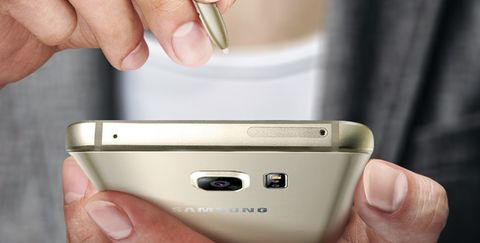Early Verdict
This is the best of Samsung’s current big-screen phones, making its limited release all the more frustrating.
Pros
- +
Excellent screen; Strong camera; Great performance; Handy pressure-sensitive stylus
Cons
- -
Non-expandable storage; Fixed battery; Not officially available in the UK; No IR transmitter; Few S Pen improvements
One of the biggest surprises of the past summer was Samsung's decision to not release its latest Galaxy Note 5 phablet in the UK (and indeed the rest of Europe). It's a puzzling decision given the popularity of previous Notes and Samsung is instead pushing the similarly sized Galaxy S6 Edge Plus. That phablet eschews the Note's trademark stylus though in favour of a screen that's gently curved on both the left and right hand edges (when held in portrait orientation).
Given its fall from favour, we expected the Note 5 to be a dud but that's not necessarily the case at all.
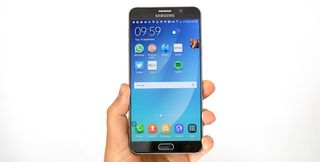
S Pen stylus
Given that Samsung did little to advance the state-of-the-art with the styluses included with the Galaxy Note 4 and Edge, it is not surprising that the stylus included with the Note 5 remains almost untouched compared to its predecessors.
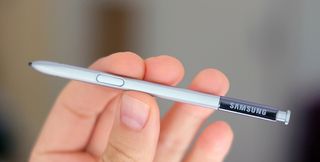
It's telling that one of the most noticeable changes is also the most superficial - a clicker at the end of the pen. This doesn't do anything but provide a way to vent stress and to give clicky feedback as the pen is removed from the phone. It is almost difficult not to click the thing incessantly.
For those intending to actually use the pen, the Samsung Air Command menu returns with a tweaked look. This is the interface hub for pen-specific features, appearing when the on-pen button is pressed or when the pen's nib is in range of the screen (around one inch).
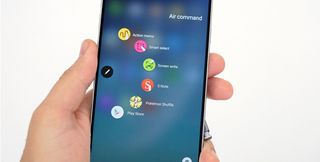
Pen-led features include note-taking and the ability to quickly and easily annotate anything onscreen (you're effectively scrawling on a screenshot of whatever you're looking at). A modest array of third-party apps supports the pressure-sensitive pen with Autodesk Sketchbook being one of the most high profile.
Like previous Notes, the Note 5 supports palm rejection so you can draw and write more easily by resting your palm against the screen without worrying about it inadvertently activating an onscreen control. Additionally, the lightly rubberised nib feels naturally pen-like, partly thanks to a tiny bit of give in its tip. This is something Samsung has gradually refined over the years.
As with previous Note phablets, the on-device, non-cloud based OCR was generally reliable. Scribbled phone numbers can be rung, while transcribed notes can be manipulated just like any other piece of text whether you want to paste and edit it in a Word document or send it to someone via email. If your handwriting flummoxes the OCR, notes can instead be exported/emailed as vector-based images.
Casing
The stylus simply slots into a little hole in the bottom of the phone, clicking into place and adding little to the phone's bulk. The Galaxy Note 5 is just 7.6mm thick - fractionally more than the Samsung Galaxy S6 Edge Plus and certainly slim by any standard.


The Note 5 eschews the plastic and fake leather of its predecessors in favour of a glass and metal construction similar to that of the Galaxy S6 and S6 Edge Plus. Indeed, it closely resembles the latter.
While the front is topped by a flat sheet of Gorilla Glass 4, the back of the Note 5 is curved with similar contours to the screens of the Edge phones. It significantly improves the feel of the phone, adding softness to a phone made of distinctly hard materials. The sides are made of 7000-series aluminium, the same material Apple has used for the casing of the iPhone 6S Plus.
This premium look and feel is very welcome after years of what felt like cheap and plasticky phablets.
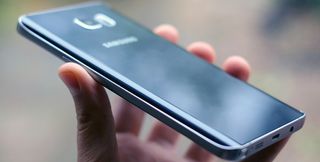
Connectivity and missing features
The new metal and glass construction isn't without its drawbacks though. In adopting it, Samsung has shed some of the feature which helped make previous Note phablets so popular - there's no microSD card slot or IR transmitter. While the former is predictable (it's an increasingly uncommon sight on expensive smartphones) and the latter rarely used by most, these omissions nonetheless chip away at the Note's reputation as the smartphone of choice for hardcore users with niche or geeky needs.

Perhaps most alarming of all is that the battery is now fixed in place. This move isn't a surprise given that Samsung had abandoned user-replaceable batteries in the Galaxy S phones. Nevertheless, it will disappoint those power users that had eschewed iPhones and Nexus phones in favour of older Notes specifically for their ability to instantly bounce back to 100% charge as long as you had spare batteries at the ready.
It's not all bad news though. The Note 5 has the same fingerprint scanner as the Galaxy S6, so it is both faster and more accurate than the frustratingly fiddly fingerprint reader used on the Note 4. And for those with even greater security needs, Samsung Knox comes preinstalled.
Display
The Galaxy Note 5's screen isn't curved, but it's otherwise comparable to the screens on other high-end Samsung Android phones. The 5.7in screen has a resolution of 2560x1440 pixels and is based on Samsung's own Super AMOLED technology.
As is common to Samsung's OLED phones, the colours are oversaturated fresh out of the box, but changing the settings to the basic' display mode gives much more accurate, natural-looking tones. Most other OLED phones continue to appear oversaturated because while the panel may be able to appear more subdued and realistic, the limited colour management settings in Google's stock version of Android means you can't change it.
The screen had near-flawless viewing angles, terrific contrast and excellent sharpness. There's a slight blue tint to the display finish as the phone is tilted, but it's far less pronounced than in the Samsung OLED screens of a few years ago. In any case, it's barely noticeable in everyday use.
Although the bezel around the screen is almost non-existent, this still doesn't disguise the fact that this is a very big phablet. Even if you only use the stylus occasionally, you'll still almost certainly spend most of your time operating it two-handed as single-handed use is very difficult especially if you have small hands.
Performance and Software
The Note 5's software is much the same as on other Samsung's other flagship Galaxy phones, bar the extra stylus elements. Previous versions of Samsung's TouchWiz UI were overburdened with extra features festooned with endless pop-up help balloons, which makes this latest, more pared-back version all the more welcome. It much more closely resembles Android 5.0 Lollipop which is the version of Google's OS sitting underneath. There are still plenty of customisations sitting under the surface if you want them though, including themes.
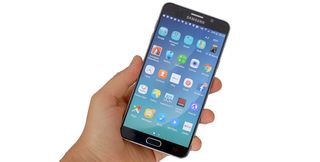
Unsurprisingly, performance is on-par with the other flagship Samsung phones, as their specs are very similar. Our review unit had an Exynos 7420 processor with 4GB DDR4 RAM. We did notice that the internal storage appears to be slightly slower though (at around 105MB/s write speed compared to 160MB/s in the S6 Edge).
Nonetheless, this processor and memory configuration make the Note 5 one of the most powerful mobile phones available at present. While the 7420's array of four Cortex-A57 high-performance cores and four slower but more power efficient Cortex-A53 cores appears to match those of the Snapdragon 810 competition, the 7420 pulls better performance out of them as it is made with a more efficient 14nm process. The Snapdragon 810 is made using a 20nm process.
In Geekbench 3 the Note 5 scores up to around 5215 points. This dropped to around 4100-4200 with power management enabled, roughly mirroring what the Snapdragon competition provides at full throttle. However, to focus too much on raw performance is to miss the bigger picture.
What sets the Note 5 apart is its efficiency, and the amount of heat its internals kick out. Where some Snapdragon 810-based phones such as the Sony Xperia Z3+ tend to get quite warm from simple tasks like web browsing, the Note 5's heat output is much lower and thus much less noticeable in your hand. It's much closer to the iPhone 6 than it is to the toasty Z3+.
It's this that helps it last for a lengthy 15.5 hours of looped (non-streamed) video playback. In general everyday use the battery lasted 26 hours which is a little low for such a big phone with a correspondingly big 3000 mAh battery. Careful use of the Note 5's battery-saving features extended this to around 30 hours. The battery does at least recharge very quickly as long as you use the included quick charge power adapter.
Camera
The Samsung Galaxy Note 5's rear camera is essentially identical to the Galaxy S6's. It has a 16-megapixel sensor, optical image stabilisation and an f/1.9 lens.
This setup combined with super-fast processing, a highly intelligent metering system and a strong Auto HDR mode make it extremely easy to get good shots from the camera with zero effort or camera know-how. This is among the best phone cameras available right now.
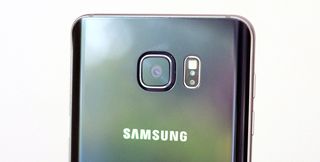
Its RAW image quality may not quite match that of the classic Nokia Lumia 1020, but this is outweighed by the Note 5's excellent HDR processing and much faster overall speed for most buyers.
The optical image stabilisation makes it easy to take sharp and clear night-time shots, but the small size of the sensor (requiring longer exposure times) means it's still no good for night-time action shots. That remains a tough ask for any phone camera though.
Other than continuing to improve higher-ISO performance, the one thing Samsung could improve next year is the lens. The Note 5's lens is slightly prone to lens flare in difficult lighting
Samsung has removed most of the extra camera modes that used to crowd its custom camera app, making them available as downloadable extras instead. Pre-loaded ones include Pro, which provides manual control over camera settings as well as time-lapse and slow motion video modes.
Oddly, the camera shoots video with software stabilisation enabled by default even though it has optical stabilisation. This crops the frame making juddery footage much smoother with an almost steadicam-like appearance. It works well enough but, given that it works by chopping bits off the top and bottom of your image, it can only be used if you're recording at 1080p 30 frames per second (fps) and not at 1080p 60fps, 2560x1440 or 4K resolutions.
Shooting in 4K isn't quite as extravagant as it first sounds. Even if you don't have a 4K monitor or TV back home or at the office to show 4K footage, the extra resolution means you can digitally zoom into scenes without losing detail (up to a point of course).
Conclusions
The only thing stranger than Samsung's decision not to sell the Galaxy Note 5 in the UK is the phablet itself. Until this year's crop of Galaxy S and Note phones, Samsung had defined its mobile products in opposition to Apple's. What Cupertino refuses to offer be it storage slots, removable batteries or IR emitters Samsung would. Until now that is by abandoning what made it different and what attracted so many users to its Android phones in the first place, Samsung is trying to out-Apple by making its mobile products even more Apple-like.
This is an understandable strategy with the Galaxy S6, but it's baffling with the Note 5 which attracted so many users for the features that Samsung has now removed. Without them, the Note 5 is essentially a bigger S6 with a pen. It's by no means a bad phablet its sturdy build, classy looks, top-notch camera and vivid screen means it's still a desirable phone. But unless you're a regular use of the pen features, and in our anecdotal experience only a small handful of existing Note users are, then you're not missing out on much by opting for the S6 Edge Plus instead.
If you are a die-hard stylus fanatic, then you're left in a quandary. Hunt down a Note 5 and lose the features that you loved in the Note 4, or snap up a Note 4, put up with its inferior camera and fingerprint reader and hope that Samsung updates it to the latest version of Android. Neither is desirable for hardcore Samsung fans who are used to having it all and it is perhaps for this reason that Samsung has decided not to sell the Note 5 in Europe an odd yet grand marketing and consumer choice experiment on a continental scale to see what its customers really want. Vote with your wallet and perhaps Samsung will finally decide on one mobile strategy or the other by this time next year.
Verdict
This is the best of Samsung’s current big-screen phones, making its limited release all the more frustrating.
Processor: 2.1 + 1.5 GHz Samsung Exynos 7420
GPU: Mali T760MP8
Screen: 2560x1440 pixels
Memory: 4GB RAM
Storage: 32GB/64GB on-board, non-expandable
Connectivity: 802.11ac Wi-Fi, Bluetooth 4.0, 4G
Ports: MicroUSB 2.0, headphone jack, nano SIM
Dimensions: (WxDxH): 153 x 76 x 7.6mm
Weight: 171g
